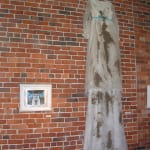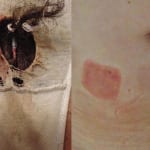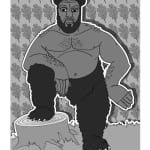Glitter Bomb Exhibition, 2015
Glitter Bomb
June 4 – 27, 2015
SOMArts Cultural Center
934 Brannan St., San Francisco
6:30-9pm
Exhibition:
Tuesday–Friday noon–7:00pm Saturday noon–5:30pm.
Artist Walkthru – June 20, 12noon
Visual Arts
GLITTER BOMB
Each year, QCC organizes a large-scale month-long exhibition of cutting-edge queer art at SomArts Cultural Center Gallery in San Francisco that serves as the National Queer Arts Festival’s kick-off event. This annual exhibition is the largest and oldest forum for queer visual art in the U.S. For the past 17 years, the exhibition has featured 30 to 60 emerging and mid-career Queer artists’ work.
This year the exhibition explores the idea of physical, social, political, affective and historical connections. For those who have been denied acceptance into existing social models and access to traditional political means, or for those who voluntarily reject these structures, queers have created alternative social connections as sites of political transformation or contestation.
Historically, LGBTQ people have made connections with each other across racial, geographic, gender, ability, age, class and cultural borders. These connections have built a strong LGBT community, generated new concepts of queer families, developed innovative health and social service models and made long lasting alliances with other disenfranchised communities and social change movements – interweaving social justice issues into our daily lives.
The exhibition asks: How do queer artists and activists make political alliances calling for change in terms of the increasing surveillance and the policing of our lives? How do we advocate for social justice for the black and brown dead killed by bad cops, rogue vigilantes, and armed racists? How do we make alliances and help expand the idea of queerness to include our voices in the struggle for equal pay, union reform, anti-imperialist, and anti-racist movements.
The exhibition asks: how do we use models from the past with the tools of the present to inform the creation of a new visual language to respond to our present cultural condition of omnipresent urgency and begin to answer the question of whether queer art can be equal to the challenge of the times?
Curatorial Committee: Darius, Bost, Việt Lê, Rudy Lemcke, Matt McKinley, Jackie Francis, Pam Peniston
Exhibition Design: Matt McKinley
Exhibition Manager: Melonie Green
GLITTER BOMB
Each year, QCC organizes a large-scale month-long exhibition of cutting-edge queer art at SomArts Cultural Center Gallery in San Francisco that serves as the National Queer Arts Festival’s kick-off event. This annual exhibition is the largest and oldest forum for queer visual art in the U.S. For the past 17 years, the exhibition has featured 30 to 60 emerging and mid-career Queer artists’ work.
This year the exhibition will explore the idea of physical, social, political, affective and historical connections. For those who have been denied acceptance into existing social models and access to traditional political means, or for those who voluntarily reject these structures, queers have created alternative social connections as sites of political transformation or contestation.
Historically, LGBTQ people have made connections with each other across racial, geographic, gender, ability, age, class and cultural borders. These connections have built a strong LGBT community, generated new concepts of queer families, developed innovative health and social service models and made long lasting alliances with other disenfranchised communities and social change movements – interweaving social justice issues into our daily lives.
For the past 40 years LGBT people have constantly forged new ways to connect within and outside of our perceived communities: body-building magazines, lesbian pulp fiction, want ads in straight publications and other 1960s practices gave way to gay newspapers, bars, sex clubs, churches and political organizations in the 1970s. In the 1990s the increasing use of digital technology proliferated the ways LGBT people could communicate and connect. With this rise of technology, we are called upon to respond to a new and increasingly rapid proliferation of political and visual culture and an array of urgent social issues that this technology makes increasingly visible.
The exhibition asks: How do queer artists and activists make political alliances calling for change in terms of the increasing surveillance and the policing of our lives? How do we advocate for social justice for the black and brown dead killed by bad cops, rogue vigilantes, and armed racists? How do we make alliances and help expand the idea of queerness to include our voices in the struggle for equal pay, union reform, anti-imperialist, and anti-racist movements.
The exhibition asks: how do we use models from the past with the tools of the present to inform the creation of a new visual language to respond to our present cultural condition of omnipresent urgency and begin to answer the question of whether queer art can be equal to the challenge of the times?
Curatorial Committee: Darius, Bost, Việt Lê, Rudy Lemcke, Matt McKinley, Jackie Francis, Pam Peniston
Exhibition Design: Matt McKinley
Exhibition Manager: Melonie Green











































